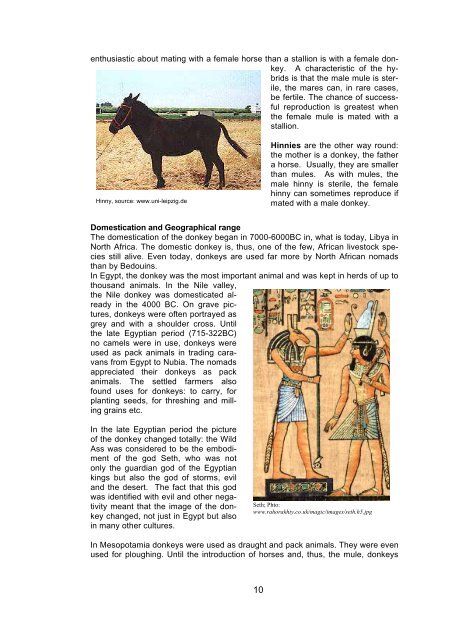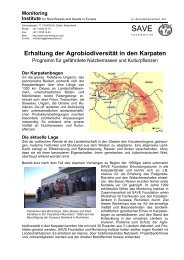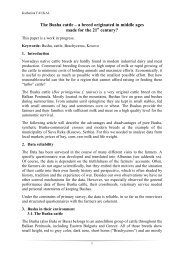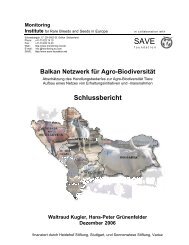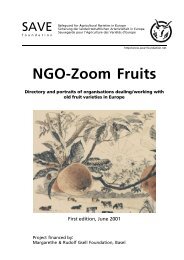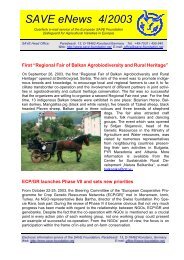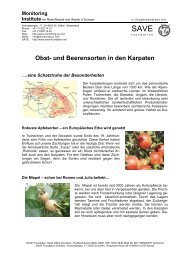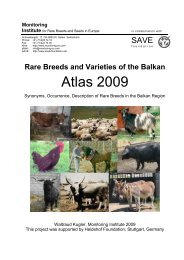Donkey Breeds in Europe - Safeguard for Agricultural Varieties in ...
Donkey Breeds in Europe - Safeguard for Agricultural Varieties in ...
Donkey Breeds in Europe - Safeguard for Agricultural Varieties in ...
You also want an ePaper? Increase the reach of your titles
YUMPU automatically turns print PDFs into web optimized ePapers that Google loves.
enthusiastic about mat<strong>in</strong>g with a female horse than a stallion is with a female donkey.<br />
A characteristic of the hybrids<br />
is that the male mule is sterile,<br />
the mares can, <strong>in</strong> rare cases,<br />
be fertile. The chance of successful<br />
reproduction is greatest when<br />
the female mule is mated with a<br />
stallion.<br />
H<strong>in</strong>ny, source: www.uni-leipzig.de<br />
10<br />
H<strong>in</strong>nies are the other way round:<br />
the mother is a donkey, the father<br />
a horse. Usually, they are smaller<br />
than mules. As with mules, the<br />
male h<strong>in</strong>ny is sterile, the female<br />
h<strong>in</strong>ny can sometimes reproduce if<br />
mated with a male donkey.<br />
Domestication and Geographical range<br />
The domestication of the donkey began <strong>in</strong> 7000-6000BC <strong>in</strong>, what is today, Libya <strong>in</strong><br />
North Africa. The domestic donkey is, thus, one of the few, African livestock species<br />
still alive. Even today, donkeys are used far more by North African nomads<br />
than by Bedou<strong>in</strong>s.<br />
In Egypt, the donkey was the most important animal and was kept <strong>in</strong> herds of up to<br />
thousand animals. In the Nile valley,<br />
the Nile donkey was domesticated already<br />
<strong>in</strong> the 4000 BC. On grave pictures,<br />
donkeys were often portrayed as<br />
grey and with a shoulder cross. Until<br />
the late Egyptian period (715-322BC)<br />
no camels were <strong>in</strong> use, donkeys were<br />
used as pack animals <strong>in</strong> trad<strong>in</strong>g caravans<br />
from Egypt to Nubia. The nomads<br />
appreciated their donkeys as pack<br />
animals. The settled farmers also<br />
found uses <strong>for</strong> donkeys: to carry, <strong>for</strong><br />
plant<strong>in</strong>g seeds, <strong>for</strong> thresh<strong>in</strong>g and mill<strong>in</strong>g<br />
gra<strong>in</strong>s etc.<br />
In the late Egyptian period the picture<br />
of the donkey changed totally: the Wild<br />
Ass was considered to be the embodiment<br />
of the god Seth, who was not<br />
only the guardian god of the Egyptian<br />
k<strong>in</strong>gs but also the god of storms, evil<br />
and the desert. The fact that this god<br />
was identified with evil and other negativity<br />
meant that the image of the donkey<br />
changed, not just <strong>in</strong> Egypt but also<br />
<strong>in</strong> many other cultures.<br />
Seth; Phto:<br />
www.rahorakhty.co.uk/magic/images/seth.h5.jpg<br />
In Mesopotamia donkeys were used as draught and pack animals. They were even<br />
used <strong>for</strong> plough<strong>in</strong>g. Until the <strong>in</strong>troduction of horses and, thus, the mule, donkeys


